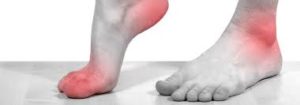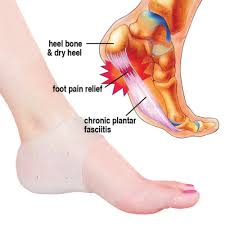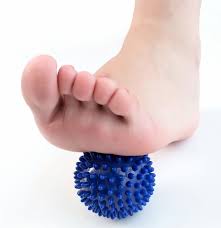What is plantar fasciitis?
Plantar fasciitis is very common and presents with heel pain radiating down towards the toes. It involves inflammation of a thick band of soft tissue that runs across the bottom of your foot and connects your heel bone to your toes (plantar fascia). It is usually more painful in the morning when you take your first steps. This is because your soft tissue is rested in a shortened position overnight. As you get up and move more in the morning, the pain normally decreases as you warm up and lengthen the soft tissue under the foot. However, the pain can also present throughout the day.
What are the early signs of plantar fasciitis?
The most common signs of plantar fasciitis are:
- Extreme pain at the bottom of your heel or mid-foot area. It will usually will affect one foot but can often affect both.
- The pain develops over a period of time and can be dull or sharp. Some describe a burning pain on the bottom of their foot.
- Getting out of bed in the morning and feeling extreme pain in your foot is a sign that you have plantar fasciitis.
What are the common causes of plantar fasciitis?

Unfortunately, plantar fasciitis is very common among men and women. Some common causes are:
- It is more prevalent in women than men. Pregnant women can often experience bouts of plantar fasciitis.
- If you are overweight, you will be more at risk. This is due to the increased pressure on your plantar fascia.
- Long-distance runners are at risk as well as workers whose job requires them to stand on their feet for most of the day.
- If you have any other structural foot issues such as very high arches or very flat feet. Tight achilles tendons and calf muscles may also be a factor so it is very important to stretch your calves daily before and after exercising.
How is plantar fasciitis diagnosed?
Your doctor or physiotherapist will perform a physical examination to check for tenderness in your foot and the exact location of pain. They will want to rule out other foot conditions, so they may request for some imaging. They will ask you to flex your foot while they push on the plantar fascia to see if your pain worsens. They will also look for mild redness or swelling.
Your doctor will also want to evaluate the strength of your muscles and the health of your nerves. They will check the following:
- Reflexes
- Muscle tone
- Sense of touch and sight
- Coordination
- Balance
How is plantar fasciitis treated?

There are various ways to treat plantar fasciitis:
- Home treatments like rest, ice, and anti-inflammatory medications are the first port of call. If this does not help, your doctor may refer you for an injection of corticosteroid directly into the painful part of your foot. This has a high success rate and normally takes your plantarfascitis pain away immediately, albeit for short periods of time. You can have three of these injections per year.
- Physiotherapy plays a very important role in treatment for plantar fasciitis pain. It will help stretch your plantar fascia and achilles tendons. Your physiotherapist will show you stretches and strengthening exercises to relieve the symptoms and lessen the workload on your plantar fascia.
- Your doctor may recommend shock wave therapy for plantar fasciitis pain relief.
Plantar fascitiis and surgery
Surgery is rarely carried out. In a plantar fascia release, your surgeon will partially detach the plantar fascia from the heel bone. This will reduce tension in time but will weaken the arch of the foot and you may lose some function.
Another surgical approach is a gastrocnemius recession. This surgery involves lengthening the calf muscle to increase ankle motion and release the stress on the plantar fascia.
Tips for treating plantar fascitiis at home

- If you are running with plantar fasciitis or playing other sports, it is recommended that you stretch your calves beforehand.
- If you are a runner, you may need to stop this temporarily and take up another sport such as swimming to avoid aggravating it further.
- Use a frozen bottle of water or a tennis ball under your foot and roll it back and forward several times a day.
- Using arch supports in your shoes will really help daily activities. These can can be bought over the counter or by seeing a podiatrist.
- Night splints are another treatment that can stretch your calf and the arch of your foot. It is a type of brace that holds your foot in a stretched position and lengthens the plantar fascia and achilles tendon overnight. Using a night splint will prevent morning pain and stiffness and may offer some pain relief.
How physiotherapy can help your plantar fasciitis pain
We will do whatever we can to get you on the fastest route to recovery. Some of the treatment methods we use include:
- Mobilisation
- Strengthening exercises
- Myofascial trigger point release
- Pilates
- Cross-friction massage
- Stretching and range of movement exercises
- Acupuncture
- Functional exercises
- Kinesio-taping
